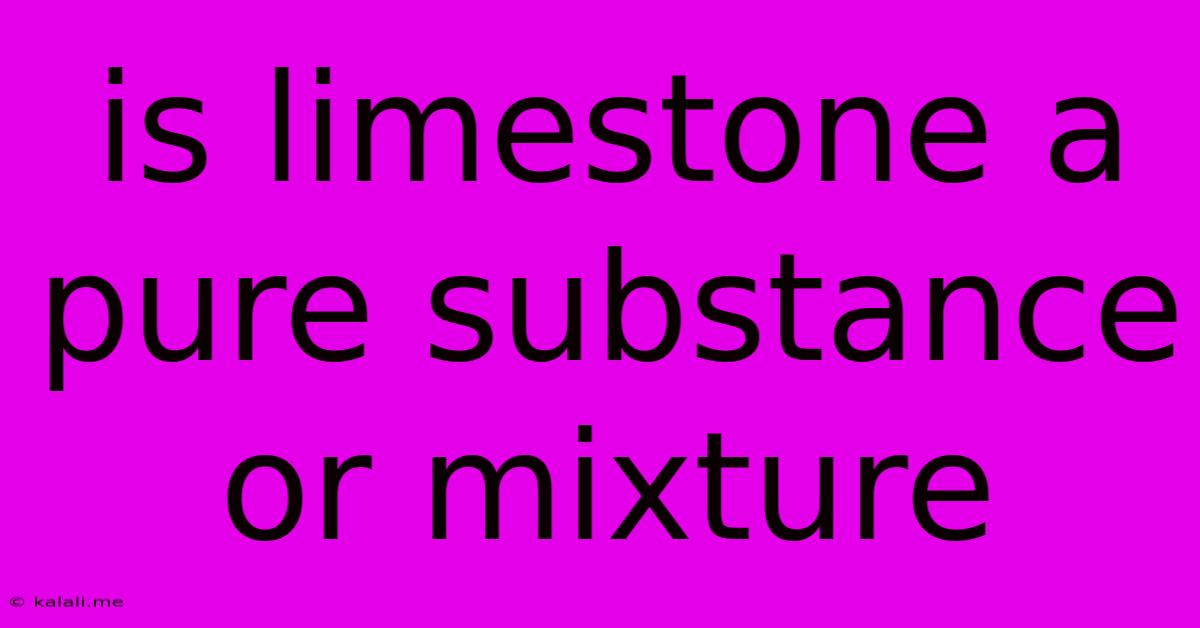Is Limestone A Pure Substance Or Mixture
Kalali
May 10, 2025 · 3 min read

Table of Contents
Is Limestone a Pure Substance or a Mixture? Understanding the Composition of Limestone
Limestone, a sedimentary rock found abundantly across the globe, is often a source of confusion when classifying it as a pure substance or a mixture. The answer, however, isn't a simple yes or no. This article will delve into the composition of limestone, exploring its multifaceted nature and clarifying its classification. Understanding whether limestone is a pure substance or a mixture hinges on its chemical makeup and the variations found in natural samples.
Limestone is primarily composed of calcium carbonate (CaCO₃). This makes it seem like a pure substance at first glance. However, the reality is much more complex. Natural limestone rarely consists solely of pure calcium carbonate. Instead, it's a mixture of various minerals and impurities.
The Mixed Nature of Limestone
Several factors contribute to the mixed nature of limestone:
- Presence of other minerals: Limestone frequently contains other carbonate minerals like dolomite (CaMg(CO₃)₂), leading to variations in its chemical composition and properties. The presence of dolomite can significantly alter the rock's physical characteristics, making it harder and more resistant to weathering.
- Impurities: The sedimentation process that forms limestone often incorporates various impurities, such as clay minerals, quartz, silica, iron oxides, and organic matter. These impurities can affect the limestone's color, texture, and overall chemical composition. For example, iron oxides can lend a reddish or brownish hue to the rock, while clay minerals might impart a darker shade.
- Fossil fragments: Many limestone formations contain fossilized remains of marine organisms like shells, corals, and other skeletal structures. These fossils contribute to the heterogeneous nature of the rock, further supporting its classification as a mixture.
- Variations in purity: The degree of purity in limestone varies significantly depending on its geological origin and formation conditions. Some limestone deposits are relatively pure, consisting mainly of calcium carbonate, while others are significantly more impure, containing substantial amounts of other minerals and materials.
Distinguishing Pure Substances from Mixtures
To further clarify the distinction, let's define the terms:
- Pure substance: A pure substance is composed of only one type of atom or molecule. It has a fixed chemical composition and consistent properties throughout. Examples include pure water (H₂O) or pure gold (Au).
- Mixture: A mixture consists of two or more substances that are physically combined but not chemically bonded. The components retain their individual properties, and their proportions can vary. Air, for instance, is a mixture of various gases.
Given this, limestone's variable composition, containing a range of minerals and impurities alongside calcium carbonate, clearly places it in the mixture category.
Types of Limestone and their Variations
Different types of limestone exist, each exhibiting variations in composition and properties:
- High-calcium limestone: This type has a higher concentration of calcium carbonate and is typically purer than other forms.
- Dolomitic limestone: This type contains a significant amount of dolomite, alongside calcium carbonate.
- Chalk: A softer type of limestone composed of microscopic coccoliths (calcium carbonate plates from marine algae).
The variations among these types highlight the diverse and often impure nature of limestone formations across the globe.
Conclusion: Limestone – A Naturally Occurring Mixture
In conclusion, while limestone's primary component is calcium carbonate, its frequent inclusion of other minerals, impurities, and fossil remains firmly classifies it as a mixture, not a pure substance. The diverse range of limestone types and the variable composition within each type reinforce this conclusion. Understanding this mixed nature is crucial in various applications, from construction to industrial processes, as the properties of limestone are directly influenced by its specific composition.
Latest Posts
Latest Posts
-
How Long To Heat Water In Microwave
Jul 18, 2025
-
40 Oz Of Water Is How Many Cups
Jul 18, 2025
-
How Many Eighths In A Quarter Pound
Jul 18, 2025
-
Can The Sine Of An Angle Ever Equal 2
Jul 18, 2025
-
How Many Months Is A Hundred Days
Jul 18, 2025
Related Post
Thank you for visiting our website which covers about Is Limestone A Pure Substance Or Mixture . We hope the information provided has been useful to you. Feel free to contact us if you have any questions or need further assistance. See you next time and don't miss to bookmark.